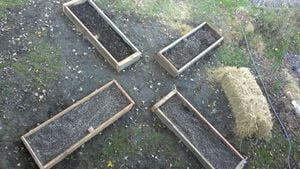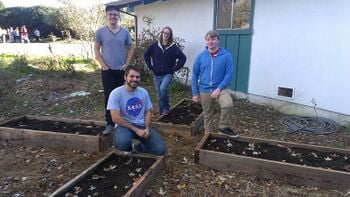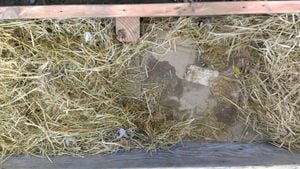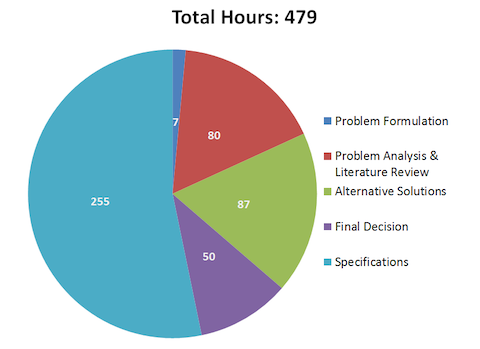

Project Growth is a garden-to-kitchen system designed in Cal Poly Humboldt's Engineering 215 class. The garden provides some salad greens for Laurel Tree Charter School's kitchen, while educating the primary age students about the importance of local agriculture. Applying the Montessori method of teaching, children will learn about gardening through hands on experience.
Background[edit | edit source]
For the Fall 2012 ENGR 215 design class at Cal Poly Humboldt, students were assigned projects to promote sustainability and education at Laurel Tree Charter School. The Garden Gnomes is a team of four students tasked to implement a garden to kitchen system. The educational aspects of the project are aimed at primary school students grades K-6.
The Garden Gnomes came up with the solution of raised garden beds to solve the task at hand. As well as the beds themselves, the design includes an interactive sign to show students whether the garden is open or closed and a toolbox to hold child-sized tools. The area surrounding the beds will be filled with mulch, increasing aesthetic appeal.
Problem Statement and Criteria[edit | edit source]
Laurel Tree Charter School serves salads to their students, but lacks a garden to produce greens in.
| Criteria | Weight | Definition |
|---|---|---|
| Safety | 10 | The health and wellbeing of persons working in the garden or eating food grown in the garden must not be jeopardized. It must be safe for children to work in and play around. Plants must be edible raw, wood must be sanded, and building codes must be followed. |
| Aesthetics | 10 | All components of the garden must be visually appealing. The garden is in front of the school, so it will be one of the first things seen by parents and visitors. |
| Maintainability | 9 | The amount of time an adult has to spend in the garden per day must be 15 minutes or less outside of harvest time. Because the teachers are the administration at Laurel Tree Charter School, they are always busy. Minimizing additional work load for them is crucial. The garden must also be self-sustaining enough to endure a summer of minimal care. |
| Effectiveness | 6.5 | The garden should produce some greens for salads to be served to the kids. |
| Educational Value | 6.5 | The garden should teach primary school aged students about the life cycle of plants, the importance of local agriculture and permaculture. |
| Cost | 5 | The cost of implementing the garden. A budget of 400$ must not be exceeded. |
Description of Final Project[edit | edit source]

The main components of Project Growth are 4 raised garden beds constructed from sanded old growth fir and redwood boards. The beds are built to the dimensions 6'2" x 2'2" and arranged in a cross formation on the ground (see Figure 1). The beds allow 6' x 2' of usable space. Inside each bed there is a 4x4 dug 18 inches into the ground and attached to the side of the bed for stability. At the bottom of each bed is a layer of cardboard topped with straw. This cardboard and straw combination is called sheet mulching and is used to prevent weeds while additionally providing nutrients to the soil as it decomposes. The beds are filled with a mixture of high quality soil, compost, and coffee grounds. At the northwest corner of the beds is an interactive sign made of driftwood and plywood. The driftwood serves as the fence post, while the plywood serves as the body of the sign. Two smaller pieces of plywood make doors on either side of the sign, allowing it to function like a cabinet.

When the doors are closed, the sign reads "See you next time, Garden is closed." When they are open, it reads "Come on in, Garden is open." This sign will help keep students out of the garden when proper supervision is not present. The Garden Gnomes also provided Laurel Tree Charter School with an assortment of gardening tools which will enable hands on experience for the students. A toolbox made out of reused cabinetry keeps the tools organized and protected from weather. All of these components together form a garden-to-kitchen system that allows the children of Laurel Tree to become actively involved in the gardening process while providing herbs and vegetables for the school kitchen.
-
Fig 3: Measuring the site
-
Fig 4: Constructing raised bed
-
Fig 5: Three beds, prepping for fourth
-
Fig 6: Sanding the beds
-
Fig 7: Preparing to add soil
-
Fig 8: Closed sign
-
Fig 9: Open sign
-
Fig 10: Bunny companion with us through it all
Costs[edit | edit source]
Implementation Cost[edit | edit source]
| Item | Quantity | Retail price per item ($) | Total | Team price per item ($) | Total |
|---|---|---|---|---|---|
| Assorted Old Growth Lumber | 16 | 15.00 | 240.00 | 0.00 | 0.00 |
| Cabinetry Scraps | 8 | 0.00 | 0.00 | 0.00 | 0.00 |
| Nails 4" long | 40 | 0.13 | 5.20 | 0.13 | 5.20 |
| Driftwood (6.5' long) | 1 | 0.00 | 0.00 | 0.00 | 0.00 |
| 1.5" Hinges | 2 | 2.00 | 4.00 | 2.00 | 4.00 |
| 3" Hinges | 4 | 4.00 | 16.00 | 4.00 | 16.00 |
| Finish | 1 | 8.98 | 8.98 | 8.98 | 8.98 |
| Sandpaper Sponges | 3 | 2.00 | 6.00 | 2.00 | 6.00 |
| Soil (ft^3) | 52 | 6.12 | 318.24 | 0.00 | 0.00 |
| Compost (ft^3) | 13 | 0.00 | 0.00 | 0.00 | 0.00 |
| Straw (bales) | 1 | 6.00 | 6.00 | 6.00 | 6.00 |
| Cardboard | 8 | 0.00 | 0.00 | 0.00 | 0.00 |
| Child-sized shovels | 6 | 2.75 | 16.50 | 2.75 | 16.50 |
| Child-sized hand rakes | 6 | 2.75 | 16.50 | 2.75 | 16.50 |
| Child-sized watering pails | 2 | 6.00 | 12.00 | 6.00 | 12.00 |
| Sawzall Rental | 1 | 37.82 | 37.82 | 37.82 | 37.82 |
| Power Sander Rental | 1 | 21.17 | 21.17 | 21.17 | 21.17 |
| Lime (40 lb. bag) | 1 | 10.00 | 10.00 | 0.00 | 0.00 |
| Assorted seeds (packs) | 6 | 1.00 | 6.00 | 1.00 | 6.00 |
| Sluggo (2.5 lb) | 1 | 16.97 | 16.97 | 16.97 | 16.97 |
| Mulch (2 ft^3 bags) | 4 | 5.99 | 23.96 | 5.99 | 23.96 |
| Total Cost | $759.34 | $197.10 | |||
Design Cost[edit | edit source]
This chart shows the individual human hours spent for the design of Project Earth. It is split up into sections for each of the five steps of the design process.
Maintenance Cost[edit | edit source]
It is estimated that two hours monthly will be spent by the client maintaining the garden. One of the hours will be spent on watering and weeding while the other hour is spent on planting and harvesting.
Testing Results[edit | edit source]
Testing is still under process. First a cover crop will be planted and harvested before planting season in Spring, when vegetables can grow more successfully.
Discussion[edit | edit source]
The Project Growth design met all criteria and specifications of Laurel Tree Charter school. It will produce some vegetables to supplement cooking at the school's kitchen. It's other aspect is to create a learning environment for primary school students to teach them of the importance of local agriculture and plant life cycles. In the Spring the cover crop will need to be cut down and mixed in the soil. Radish, broccoli, borage, arugula, and lettuce will then be planted. During the growing phase, students will get hands on experience on gardening, and will then be tested on their knowledge of the growing process.








